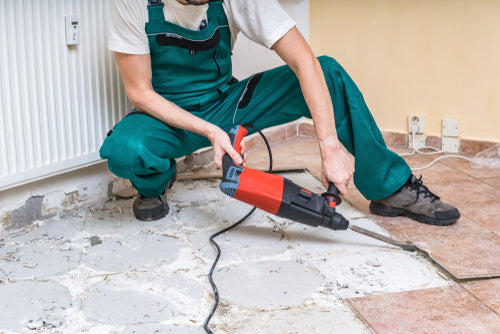
How to Remove Laminate Flooring: A Step-by-Step Guide
If you’re planning on removing your old laminate flooring to give your home a well-needed makeover, then look no further, we have compiled an easy guide to help you through the process.
Floor removal can be a tricky thing to navigate, but the right amount of tools, knowledge, and a can-do attitude is all you need!
Tools and Materials
Removing laminate flooring is a fairly straightforward process, as there is no glue or nails involved in the installation.
However, if your laminate flooring is an older design, there may be some laborious work ahead to break apart the adhesive.
Before you begin the removal, you will need certain tools:
- A pry bar or hammer to pry apart the structure.
- A utility knife to cut through glue on older models.
- A floor scraper to remove any stubborn materials.
- A chisel to remove any trims.
- A screwdriver to remove any nails (optional).
- Gloves, safety goggles, and a dust mask to protect yourself.
- Disposal bags and cleaning products to tidy the area.
Preparation
It is important to prep the area to make the process as easy and efficient as possible. Make sure to clear aside any furniture or rugs you don’t want to get ruined.
If you don’t have anywhere to store certain pieces of furniture, it may be beneficial to cover items with sheets to protect them from damage.
If you are working near any electrical outlets or appliances, it is advised that you turn off the power source in the room and remove any electrical appliances nearby to avoid any electrical hazards.
A Step-by-Step Guide
Start at the Edge
Remove the skirting boards that surround the edge of the walls using a hammer and a chisel to gently pry off the trims. This will allow you to access the laminate flooring to begin the process.
Identify the wall where the laminate flooring was first installed, which can be identified through the least amount of cuts or finding the longest row of laminate planks. Once you have located this wall, start removing the laminate in the area surrounding it.
Working from the edge inwards makes it easy to rip up the first piece of flooring due to the expansion gap that was left around the walls when it was first installed. This provides you with a wedge to pry up the planks.
Pry up the First Plank
Using a pry bar or a hammer, gently lift up the edge of the first plank at 45 degrees to slowly break it apart from the floor.
Once you have created enough space between the laminate and the underlayment, use your hands or a pair of pliers to completely pull apart the plank.
When you are doing this, avoid using too much strength on the plank to protect the floor underneath and prevent too much damage to the planks. Modern laminate flooring can be re-used as there is no adhesive or nails involved, so keep this in mind for future projects.
Remove Subsequent Planks
Once the first laminate plank has been moved, this will make it easier to break apart the rest of the structure.
Remove the planks row by row to keep a steady structure and cover more ground as you’re going along. If the floor has been nailed or glued down, you will need to use extra force to break the structure apart.
If you would like to re-use the flooring, avoid using sharp objects such as your chisel, as it may damage the planks, making them unsuitable for future use.
Remove Underlayment
Once you have completed the removal process of the planks, you will be able to see the condition of the underlayment that remains.
To remove this, simply roll up the underlayment carefully and place it to one side. If your underlay is nailed or stapled to the floor, use a hammer or pliers to remove the pieces, or if it is glued down, use a scraper to gently remove the material from the floor.
The underlayment has to be removed if you wish to place down a new floor in your home.
Clean the Subfloor
Now that the removal process is finished, you can now tidy up the area. You can use a brush or vacuum to sweep away the debris and get rid of any remaining bits of material.
You may need to use the scraper if any remaining adhesive is left on the floor from the underlayment.
Dispose of the Materials
Place your underlayment and laminate pieces into a disposable bag and check your local waste regulations to determine where to place it.
Recycle centres now accept most laminate flooring, so check if your local area will take it.
You can also up-cycle it and give it to other homes, or if you would like to reuse the materials for future projects, store the flooring in a dry, secure place until necessary.
Buy your Laminate Flooring With us
At Mersey Flooring, we offer a broad range of laminate flooring that is durable and long-lasting and can handle much more than your average floor.
If you have messy children in your home, laminate flooring is the perfect option, as it can tackle stains and dust, and withstand sharp objects and force. We will consult with you to find the best option for your home and run through the installation and acclimation process.
With plenty of colours and styles to choose from, there’s something for everyone! Contact us today and browse our range of laminate floors to find the perfect new addition to your living space.